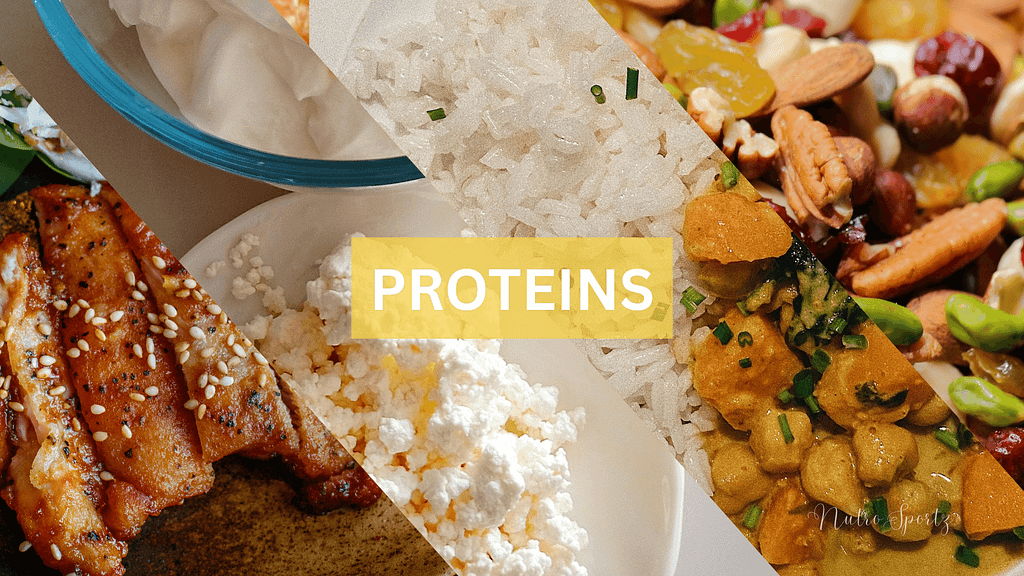As an athlete, you know how important protein is for muscle recovery💪 and growth. But do you know how to get 10 grams of protein from your meals, which foods to eat, and how much to eat? In this post, I will teach you simple, practical ways to reach your protein goals, one bite at a time.
By the end of this post, you will have a clear understanding of how much protein you need and what portions of food you need to meet that requirement. Whether you are lifting weights, running, or recovering, I will show you how to easily hit that 10-gram mark, helping you optimize your recovery and boost your athletic performance🏃♂️.
Ready to level up your nutrition?
Let’s dive in!
Table of Contents
what are proteins?
Proteins are one of the three macronutrients (the other two- carbohydrates and fats) required in large amounts by the body comparable to micronutrients (vitamins and minerals).
Proteins are made up of amino acids known as building blocks of protein. Imagine amino acids as blocks of “Lego” that join together to form protein.
You must have heard of or seen supplements of glutamine, arginine, and BCAAs (Branched Chain Amino Acids), right? Do you know what these are? Correct. These are amino acids. Kudos to you👏!
Amino acids are of two types- essential and non-essential amino acids. Our body can produce only non-essential amino acids while we need to get essential amino acids through our diet.
What happens to protein when you eat food?
When you eat a protein-containing meal, the protein breaks down into free amino acids after digestion. These free amino acids are either used for protein synthesis or used for energy when the diet is inadequate in energy (calories).
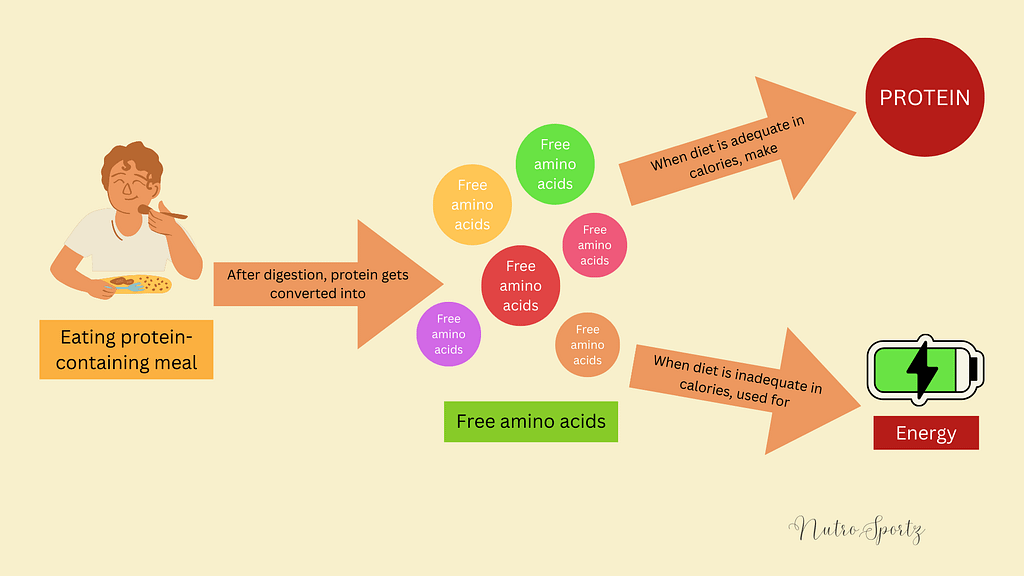
how many types are there?
Based on the presence of all essential amino acids in food, proteins can be classified into- complete and incomplete proteins.
- Complete proteins: Foods that have all the essential amino acids are referred to as complete proteins. These include foods we get from animals like meat, eggs, fish, poultry, and dairy foods (milk, paneer, cheese, curd).
Some plant-based foods are also considered complete proteins because they contain all the essential amino acids in the required amounts. Tempeh, tofu, quinoa, buckwheat, and edamame are the examples.
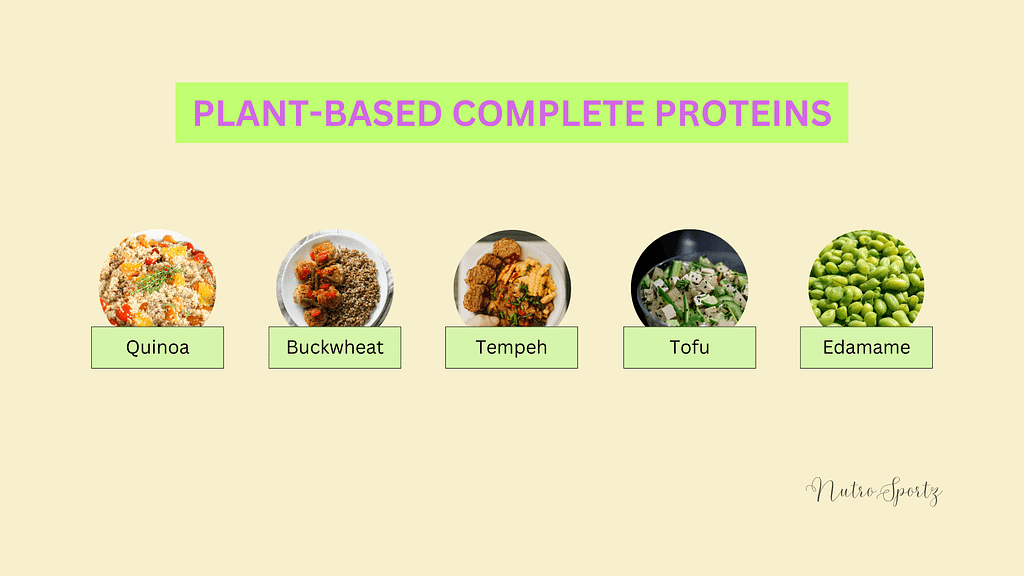
- Incomplete proteins: Foods that lack one or more essential amino acids are known as incomplete proteins. Plant-based foods like grains, pulses, legumes, nuts, and seeds are incomplete proteins.
why you should include protein in your diet?
Did you say “building muscle”? You are right but not completely. There are things other than muscle building also for which proteins are needed. Our body needs protein for:
- Growth, repair, and maintenance of cells and tissues
- Production of hormones and enzymes
- Supporting the immune system
What are the food sources of protein?
- Animal-based sources: These include animal food as a protein source. Sources include dairy food (cheese, paneer, milk, curd), meat, eggs, poultry, and fish.
- Plant-based sources: As the name suggests, these are the sources we get from plants. Examples include pulses, legumes, grains, tofu, soy chunks, nuts, and seeds.
What is protein balance and why it matters?
When muscle protein synthesis (MPS) is more than muscle protein breakdown (MPB), the net protein balance is positive, which will help you gain muscle mass.
When you don’t eat food for a long time (e.g. during fasting or sleep), when your carbohydrate intake is low, or when you have low energy availability, the protein in your body breaks down to provide energy. Hence, the protein breakdown will be more than protein synthesis, and the net protein balance will become negative.
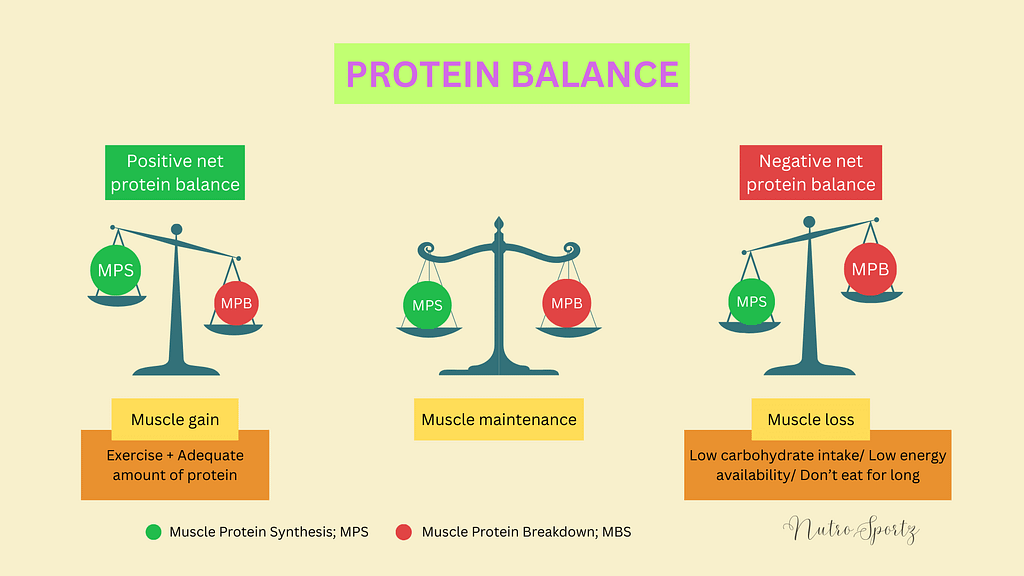
To achieve a positive net protein balance, you should exercise and consume adequate amounts of protein in your meals daily.
But consuming protein alone while making carbohydrates enemy won’t help you. You should consume proteins along with carbohydrates for optimal protein synthesis and spare protein to perform its functions instead of providing energy.
Key Takeaway: Consume an adequate amount of protein along with carbohydrates at every meal.
How much protein do you need?
You as an athlete require protein to support adaptation and muscular repair in response to exercise. You should consume 1.2 – 2.0 grams of protein per kg body mass per day (g/kg BM/day).
Example- If you weigh 60 kg and need 1.8 g/kg BM/day of protein, then the total protein you need to consume in a day would be 108 g (calculated as 1.8 x 60 = 108 g).
Sometimes you might need a higher intake of protein to:
- Adapt/recover when you have high-intensity training, you train more times than before or have a new training regimen.
- Help maintain muscle mass when sudden or reduced inactivity occurs (e.g. during injury).
- Prevent increased protein oxidation (proteins are used to provide energy) when your carbohydrate intake is low, or if you have low energy availability (energy available for body functions after used for exercise).
How to meet these requirements?
3 T’s that you should consider to meet the protein requirements are: Total, Timing, and Type.
Total means the amount of protein you consume. You should evenly distribute the amount of protein among all meals (breakfast, lunch, snacks, dinner). This means consuming ~20-40 g or 0.25-0.30 g/Kg BM of protein in every meal.
Timing refers to the time of eating a protein-containing meal. Consume a protein-containing meal every 3-4 hours. Eat a high-quality protein source within 30-60 minutes after training as the protein synthesis is more during this time.
Type means the type of protein you eat- complete or incomplete proteins.
Which sources to choose?
Let’s dive a little deeper into protein sources. When choosing protein sources, considering their protein quality is of utmost importance. Now you must be thinking what does this protein quality mean? Well, it is like deciding on the quality of vegetables based on their firmness and freshness when you go to the market.
Similarly, protein sources can also be of high quality and low quality. There are a few points that are considered when deciding the quality of protein.
These points are:
- Presence of all essential amino acids
- Digestibility of proteins present
Proteins in plant-based foods lack one or more essential amino acids and have a low digestibility. Also, you need to consume plant-based foods in more amounts to get an adequate amount of proteins comparable to animal foods, which means consuming more calories too.
Does this mean if you are a vegetarian or vegan, you won’t be able to meet the protein requirements? NO. You can still meet your protein requirements if planned carefully.
Let me tell you how to do it.
- Eat a variety of protein sources (diversification).
- Combine different plant-based protein sources (mutual supplementation).
- Heat, soak or boil food to improve the digestibility.
Key Takeaway: Even if you are a vegetarian, you can still meet the protein requirements.
Mutual supplementation
Mutual supplementation is a strategy that includes combining different plant-based sources to get all the essential amino acids in a meal. If one food group lacks an essential amino acid, then you should eat it with the food group that is adequate in that essential amino acid, to get all the essential amino acids.
Think about how doubles is played in badminton🏸 or volleyball🏐. When two players come together, their diverse skills complement each other, creating a powerful, cohesive team that works seamlessly.
Now, picture food in the same way. When you combine two different food groups, they work together like a dream team, complementing each other to deliver all the essential amino acids your body needs.
Just like a winning squad, it’s all about balance, synergy, and making sure every part plays its role to perfection.
Examples of Mutual Supplementation
- Dal/ legumes with rice/ chapati
- Dosa/ idli/ uttapam made with rice and black gram dal
- Hummus made with chickpeas and sesame seeds
Key Takeaway: Combine different sources of plant-based protein to make a complete protein.
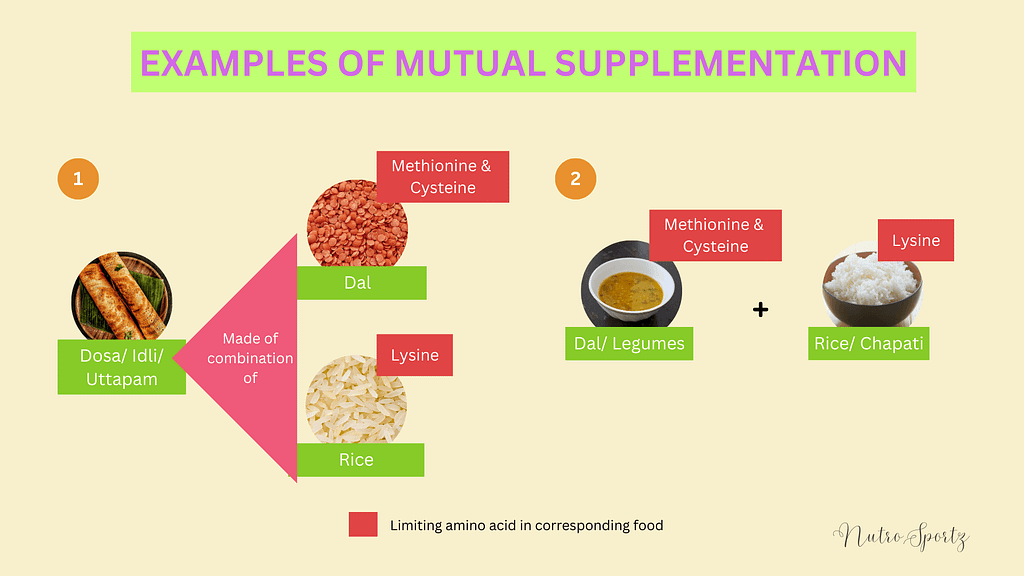
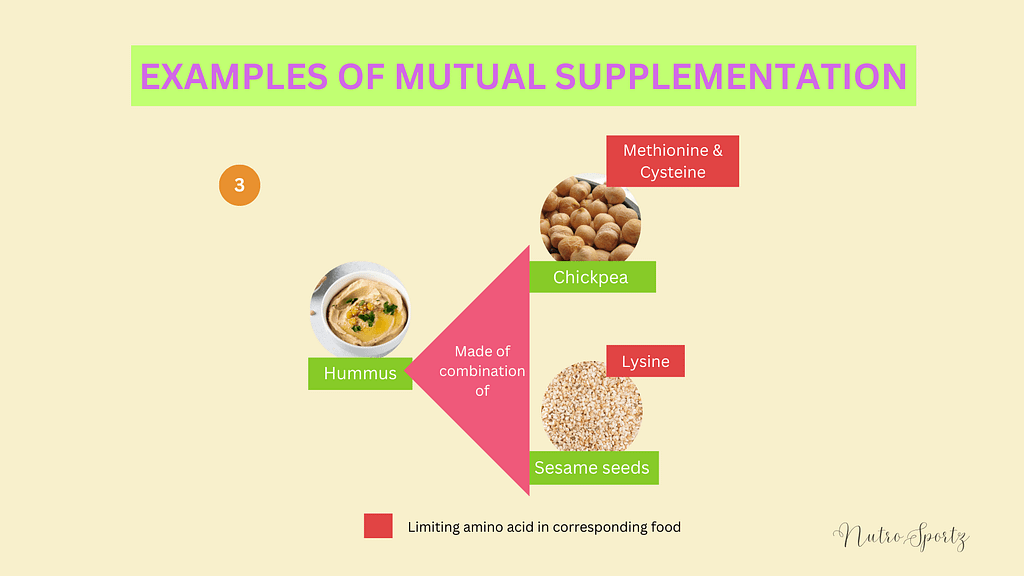
How much food equals 10 grams of protein?
It can be tricky to figure out which foods will give you the right amount of protein, especially when you are balancing intense training sessions and a busy schedule.
But how do you know if you’re hitting your target of 10 grams? The key is understanding which foods are rich in protein and how much you need to consume.
The 10 grams mark is specifically chosen because it is easy to double for 20 grams or multiply by 3 or 4 to get 30 or 40 grams, depending on your requirements.
In the table below👇, I’ve listed some common protein-containing foods and showed how much of each equals 10 grams of protein.
Peek Inside The Table: Portion Size Of Foods Containing 10 Grams Of Protein
| Food | Portion size (g/ oz) | Portion size |
|---|---|---|
| Grains & Pasta | ||
| Chapati (small) | Each chapati of 33 g/ 1.2 oz | 4 no. |
| Rice (cooked) | 360 g/ 12.7 oz | 2 ¼ cups |
| Bread | Each slice of 27 g/ 0.95 oz | 4 slices |
| Suji (Semolina) upma | 330 g/ 11.64 oz | 1 ½ cups |
| Seviyan (Vermicelli) upma | 335 g/ 11.8 oz | 1 ¾ cup |
| Poha (Rice flakes) | 220 g/ 7.76 oz | 1 ½ cup |
| Ragi mudde (Finger millet balls) | Each ball of 122 g/ 4.3 oz | 3 ½ no. |
| Pasta | 230 g/ 8.1 oz | 1 ¼ cup |
| Breakfast & Snacks | ||
| Oatmeal | 200 g/ 7.05 oz | ¾ cup ( ¾ cup milk, 2 ½ T oats, 1 T sugar) |
| Cornflakes | 275 g/ 9.7 oz | 1 cup (1 cup milk, 6 T cornflakes, 2 t sugar) |
| Muesli | 300 g/ 10.6 oz | 1 and 1/3 cup (1 cup milk, 6 T muesli, 1 t sugar) |
| Ragi malt (Finger millet porridge) | 550 g/ 19.4 oz | 2 ½ cups |
| Dhokla | Each dhokla of 55 g/ 1.9 oz | 3 pieces |
| Cheela (medium) | Each cheela of 40 g/ 1.4 oz | 2 no. |
| Dosa | Each dosa of 44 g/ 1.6 oz | 2 ½ no. |
| Uttapam (medium) | Each uttapam of 94 g/ 3.3 oz | 2 no. |
| Idli (medium) | Each idli of 40 g/ 1.4 oz | 5 no. |
| Pulses & Legumes | ||
| Dal (Pulses) | 195 g/ 6.9 oz | ¾ cup |
| Legumes (rajma, chole, kala chana) | 160 g/ 5.64 oz | 2/3 cup |
| Sprouts (green gram/ moong) | 85 g/ 3.0 oz | ¾ cup |
| Sambar | 1 ¼ cup | |
| Hummus | 140 g/ 4.9 oz | ½ cup |
| Soy | ||
| Soy chunks | 60 g/ 2.1 oz | 17-20 chunks |
| Soya bhurji | 70 g/ 2.46 oz | ½ cup |
| Tofu | 120 g/ 4.2 oz | 7 pieces |
| Dairy | ||
| Milk | 280 ml | 1 ¼ cup |
| Milkshake | 280 ml | 1 ¼ cup |
| Curd | 280 g/ 9.9 oz | 1 ¼ cup |
| Paneer | 75 g/ 2.6 oz | 8-9 paneer cubes |
| Paneer bhurji | 85 g/ 3.0 oz | 1/3 cup |
| Cheese slice | 50 g/ 1.8 oz | 2 ½ no. |
| Cheese cube | 50 g/ 1.8 oz | 2 no. |
| Poultry & Red meat | ||
| Whole egg (boiled) (medium) | 85 g/ 3.0 oz | 1 ½ no. |
| Egg whites (boiled) (medium) | 75 g/ 2.64 oz | 2 no. |
| Omelette (whole egg) | 75 g/ 2.64 oz | Made with 2 whole eggs (medium) |
| Omelette (egg white) | 65 g/ 2.3 oz | Made with 3 egg whites (medium) |
| Chicken, breast | 45 g/ 1.6 oz | ¼ piece |
| Chicken, leg | 50 g/ 1.8 oz | ½ piece |
| Chicken, thigh (medium) | 55 g/ 1.9 oz | ½ -1 piece |
| Mutton | 50 g/ 1.8 oz | 1-2 piece |
| Fish & Seafood | ||
| Fish (Rohu) (medium) | 50 g/ 1.8 oz | 1 piece |
| Salmon (large) | 50 g/ 1.8 oz | 1/5 piece |
| Prawns (medium) | 60 g/ 2.1 oz | 4-7 pieces |
| Tuna (medium) | 40 g/ 1.4 oz | ½ piece |
| Others | ||
| Protein bar | 50 g/ 1.8 oz | 1 no. |
| Peanut butter | 36 g/ 1.3 oz | 3 T |
| Skimmed milk powder | 25 g/ 0.9 oz | 4 T |
| Trail mix (Nuts and seeds mixture) | 10 almonds, 10 cashews, 6 halves of walnuts, 10 raisins, 1 T flaxseed, 1 t sunflower seeds | |
Some Pointers
- Food portion sizes are approximate. It is completely okay if you eat a little less or more.
- The weight of foods listed in the table refers to the edible portion.
- The portion sizes for some foods mentioned in the table are not required to be consumed in one day. Always aim for a balanced diet.
- When choosing a portion size for trail mix, peanut butter, cheese slice, cheese cube, hummus, or paneer consider the fat content and calories as well, not just the protein.
- Keep in mind that protein bars have supplements.
- Read the nutrition labels of packaged foods to know their protein content and portion sizes.
- The cups, teaspoons, and tablespoons mentioned in the table are measured level, not heaping.
Images of measured portions of food
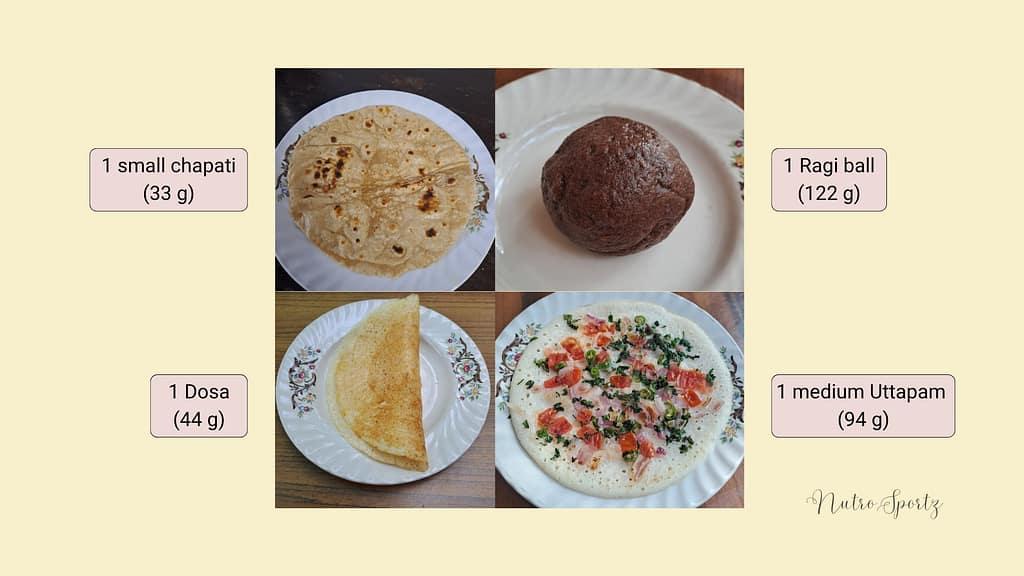

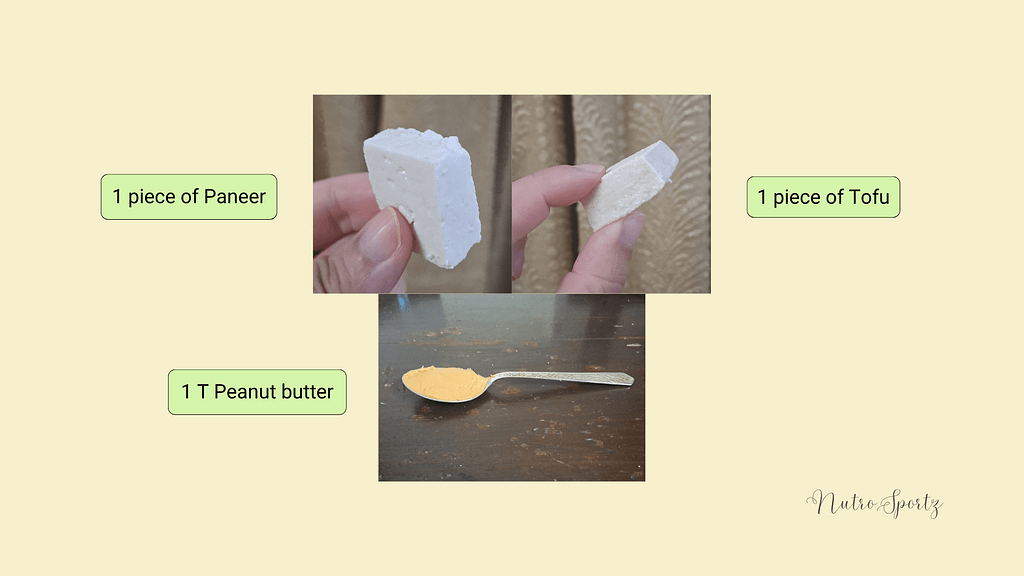
Infographics of portion size of foods containing 10 grams of protein

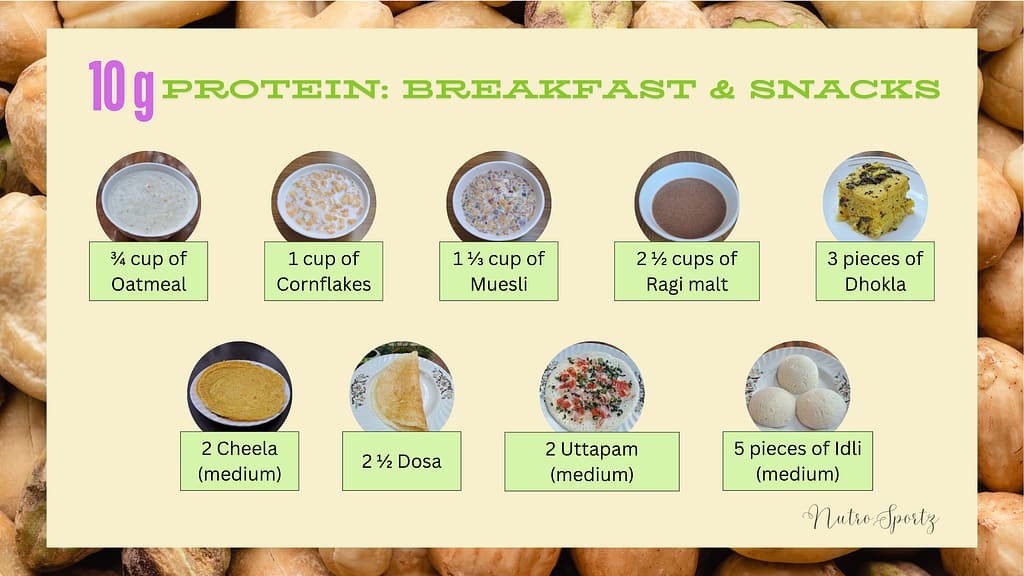




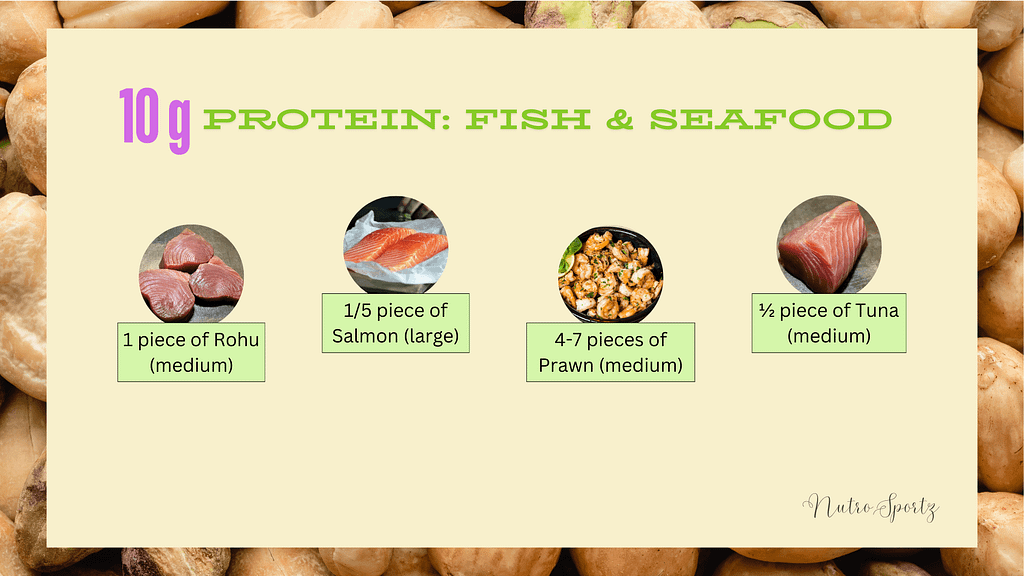

Portioning tips and tools
It must be overwhelming for you to portion your food accurately while juggling training and busy schedules. But with a few easy tools and tips, you can effortlessly measure the right amount of food to meet your protein needs—whether it is 10 grams or more per meal.
Here are some simple methods to help you portion your food accurately:
- Use a Food Scale
- Measuring Cups and Spoons
- Smart Label Reading
I’ve gone into detail about these techniques in my post, “How to Portion Your Food to Get 30 Grams of Carbohydrates”.
how to calculate the protein content in one serving of packaged food
Now, let’s focus on figuring out how much protein is in a single serving of packaged food. While some labels clearly show the protein content per serving, others don’t. If you ever find yourself in this situation, don’t worry! Just follow the steps in the image below👇, and you will have the protein value in no time.
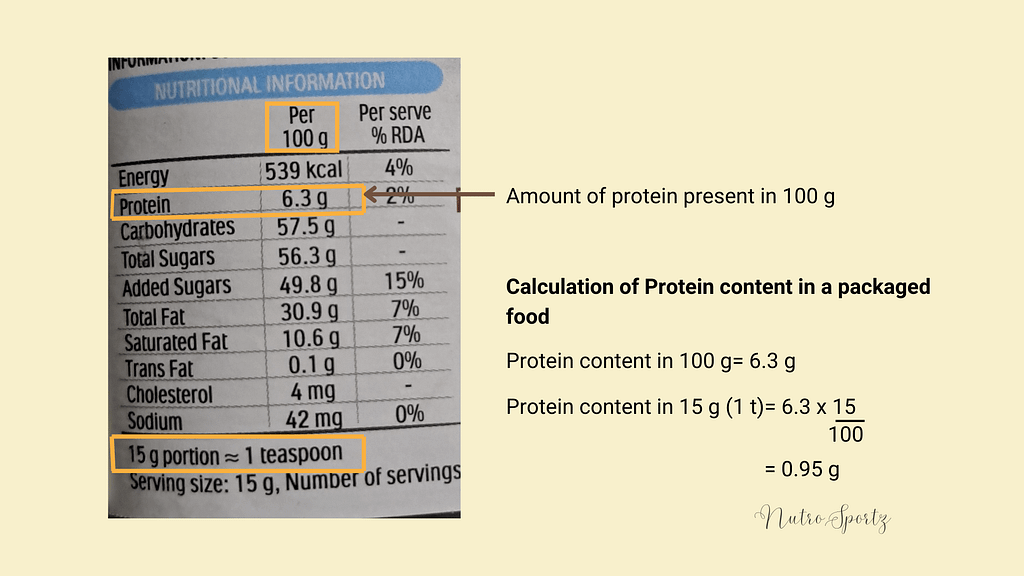
How to adjust meal protein content when you need more?
By now, you might have a pretty good idea of how much food you need to reach 10 grams of protein. But what if you need more? Don’t worry—I’ll guide you through the process, step by step, to help you adjust your meal’s protein content to meet the goals.
I’ve covered this process in my post, “How to Portion Your Food to Get 30 Grams of Carbohydrates”. If you haven’t had a chance to read it, no problem—we will go over the steps again, one by one.
1. choose a good quality protein-containing food
Start by selecting high-quality protein-containing food or a combination of foods that complement each other. Check out the table for a variety of options to help you pick the right sources.
2. check the portion size of each food
Knowing the correct portion sizes will make meal planning much easier. Refer to the table or infographics to find the portion sizes for the protein sources you choose.
3. note the portion size and protein content of each food item
Note the portion size and protein content of each food you choose.
4. add up the protein content
Simply add the protein content of each food item you have included to calculate the total protein in your meal.
5. check if it meets your protein requirement
Once you have added up all the protein values, check if it meets your target. If it is too high or too low, adjust the portion sizes—either increase or decrease them—until you reach the desired amount.
See? It is that simple! With these steps, you can easily tailor your meals to meet your protein needs.
Take A Look At Step-by-step Example: How To Adjust The Protein Content Of Your Meal
Let’s say your goal is to consume 30 grams of protein for lunch. Here’s how you can achieve that:
Imagine you have planned a lunch that includes chapati, rice, dal or chicken leg (if you are non-vegetarian), and curd. The next step is to check the portion sizes for each food item using the table or infographics.
Here’s what you find:
- 4 chapati = 10 grams of protein
- 3 cups of rice = 10 grams of protein
- ¾ cup of dal or ½ piece (50g) of chicken leg = 10 grams of protein
- 1 ¼ cups of curd = 10 grams of protein
Now, let’s break it down to adjust the portions and meet your 30-gram protein goal:
- If 4 chapati provide 10 grams of protein, then 2 chapati will give you 5 grams.
- 2 ¼ cups of rice provide 10 grams of protein, no need to adjust here.
- ¾ cup of dal or ½ piece (50g) of chicken leg gives you 10 grams of protein—perfect as is.
- If 1 ¼ cup of curd equals 10 grams of protein, then a little more than ½ cup of curd will give you 5 grams.
Don’t forget to add vegetables and a salad for a wholesome nutritious meal👌!
Now, simply add up the protein from all the foods:
- 2 chapatis = 5g
- 2 ¼ cups of rice = 10g
- ¾ cup dal or ½ chicken leg = 10g
- A little more than ½ cup of curd = 5g
Total protein = 5 + 10 + 10 + 5 = 30 grams
Let’s take a look at the quality of the proteins also.
- You have combined pulses (dal) with grains (chapati and rice), which is a great protein pairing.
- Additionally, chicken and curd are included, as they are excellent sources of high-quality protein.
Yay🙌! Your lunch is all set; packed with adequate high-quality protein your body needs.

final thoughts
In conclusion, hitting your protein goals doesn’t have to be complicated. By knowing which foods provide the right amount of protein, like the ones covered in this post, you can easily incorporate them into your meals to support your athletic goals.
Remember, consistency is key🗝️—so make protein a part of every meal, and with the right planning, you will be ready to crush your training and recovery💪.
References
- Brown, L., Tarnowski, C., Randell, R., Lee, K., Luhrs, K., Freese, E., Carter, J., and Rollo, I. (2022). Sports Nutrition Toolkit: Practical tools for qualified professionals working with athletes. Gatorade Sports Science Institute.
- Clark, N. (2008). Sports nutrition guidebook. Human kinetics. 4th edition.
- Gopalan, C., Rama Sastri, B.V., and Balasubramanian, S.C. (2018). Nutritive value of Indian foods. National Institute of Nutrition.
- Gropper, S.S. and Smith, J.L. (2013). Advanced nutrition and human metabolism. 6th edition. (pp. 183-245).
- Longvah, T., Ananthan, R., Bhaskarachary, K., and Venkaiah, K. (2017). Longvah, T. (Ed). Indian food composition tables. National Institute of Nutrition.
- Phillips, S.M. (2017). Current concepts and unresolved questions in dietary protein requirements and supplements in adults. Front. Nutr. Volume 4.
- Phillips, S.M. (2023). Current concepts and unresolved questions in dietary protein requirements and supplements in adults. Front. Nutr. Volume 9.
- Sports and exercise nutrition. (2011). Lanham-New, S., Stear, S., Shireffs, S., and Collins, A. (Eds). Nutrition society Textbook Series. Wiley-Blackwell. (pp. 41-47).
- Stein, K., Baker, L., Rollo, I. and Bailey, S. the female athlete: Sports nutrition and hydration resources for practitioners. Gatorade Sports Science Institute. (pp. 11-18).
Time to wrap up
I’d love to hear from you! Give these tips a try and let me know how this post has helped you with portioning your meals in the comments below👇.

